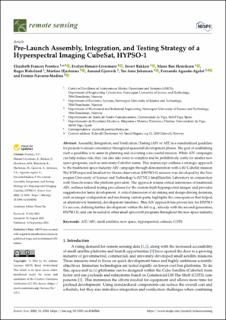| dc.contributor.author | Prentice, Elizabeth | |
| dc.contributor.author | Honoré-Livermore, Evelyn | |
| dc.contributor.author | Bakken, Sivert | |
| dc.contributor.author | Henriksen, Marie Bøe | |
| dc.contributor.author | Birkeland, Roger | |
| dc.contributor.author | Hjertenæs, Martine Aasen | |
| dc.contributor.author | Gjersvik, Amund | |
| dc.contributor.author | Johansen, Tor Arne | |
| dc.contributor.author | Agelet, Fernando Aguado | |
| dc.contributor.author | Navarro-Medina, Fermin | |
| dc.date.accessioned | 2023-02-16T13:45:19Z | |
| dc.date.available | 2023-02-16T13:45:19Z | |
| dc.date.created | 2022-11-07T12:34:07Z | |
| dc.date.issued | 2022 | |
| dc.identifier.citation | Remote Sensing. 2022, 14 (18), . | en_US |
| dc.identifier.issn | 2072-4292 | |
| dc.identifier.uri | https://hdl.handle.net/11250/3051572 | |
| dc.description.abstract | Assembly, Integration, and Verification/Testing (AIV or AIT) is a standardized guideline for projects to ensure consistency throughout spacecraft development phases. The goal of establishing such a guideline is to assist in planning and executing a successful mission. While AIV campaigns can help reduce risk, they can also take years to complete and be prohibitively costly for smaller new space programs, such as university CubeSat teams. This manuscript outlines a strategic approach to the traditional space industry AIV campaign through demonstration with a 6U CubeSat mission. The HYPerspectral Smallsat for Ocean observation (HYPSO-1) mission was developed by the Norwegian University of Science and Technology’s (NTNU) SmallSatellite Laboratory in conjunction with NanoAvionics (the platform provider). The approach retains critical milestones of traditional AIV, outlines tailored testing procedures for the custom-built hyperspectral imager, and provides suggestions for faster development. A critical discussion of de-risking and design-driving decisions, such as imager configuration and machining custom parts, highlights the consequences that helped, or alternatively hindered, development timelines. This AIV approach has proven key for HYPSO-1’s success, defining further development within the lab (e.g., already with the second-generation, HYPSO-2), and can be scaled to other small spacecraft programs throughout the new space industry. | en_US |
| dc.language.iso | eng | en_US |
| dc.publisher | MDPI | en_US |
| dc.rights | Navngivelse 4.0 Internasjonal | * |
| dc.rights.uri | http://creativecommons.org/licenses/by/4.0/deed.no | * |
| dc.title | Pre-Launch Assembly, Integration, and Testing Strategy of a Hyperspectral Imaging CubeSat, HYPSO-1 | en_US |
| dc.title.alternative | Pre-Launch Assembly, Integration, and Testing Strategy of a Hyperspectral Imaging CubeSat, HYPSO-1 | en_US |
| dc.type | Peer reviewed | en_US |
| dc.type | Journal article | en_US |
| dc.description.version | publishedVersion | en_US |
| dc.source.pagenumber | 33 | en_US |
| dc.source.volume | 14 | en_US |
| dc.source.journal | Remote Sensing | en_US |
| dc.source.issue | 18 | en_US |
| dc.identifier.doi | 10.3390/rs14184584 | |
| dc.identifier.cristin | 2069928 | |
| dc.relation.project | Norges forskningsråd: 223254 | en_US |
| dc.relation.project | Norges forskningsråd: 270959 | en_US |
| dc.relation.project | ESA - den europeiske romfartsorganisasjonen: PRODEX—4000132515 | en_US |
| cristin.ispublished | true | |
| cristin.fulltext | original | |
| cristin.qualitycode | 1 | |

